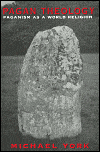
Michael York (not the actor but the director of the Sophia Centre for the Study of Cultural Astronomy, Bath Spa University College, U.K.) sets out to prove that paganism is a legitimate religion. To do so, he describes paganism as religion, behavior, and theology.
We’ve heard several definitions of the word pagan over the years. The most popular has been “country person,” as opposed to city person; a thousand years ago, city people were increasingly Christian. To the Roman, York says, paganus actually “referred to ‘a person of the place,’ whether town or country, who preserved the native customs of [the] locality. The pagan contrasted with the alienus, the ‘person from elsewhere,’ who increasingly was Christian and out of touch with indigenous expressions of polytheism.” The alternative designation for pagan in the eastern Mediterranean was Hellene, “which suggests that the pagan could be equally urban and cultured” (p. 12). After referring to a number of religious encyclopedias, York settles on the following list of characteristics of pagans. Paganism includes
(1) a number of both male and female gods, (2) magical practice, (3) emphasis on ritual efficacy, (4) corpospirituality [by which he means embodied spiritualism, i.e., that the spiritual includes the physical], and (5) an understanding of gods and humans as codependent and related. Paganism has no belief in historic revelation, and while the myths and stories about the gods are chiefly to be understood as metaphors, the divine itself is to experienced directly (p. 14).
In chapter 1, Paganism as Religion (58 pages, 231 scholarly footnotes), York examines Chinese folk religion, Japanese Shinto, primal tribal religion, shamanism, Amerindian spirituality, Afro-American spiritism, and contemporary Western paganism to find common features that constitute a pagan religion “to rank alongside … Christianity, Islam, Hinduism, Buddhism, agnosticism, and atheism” (p. 65). He finds animism, pantheim, polytheism, nature worship, magic, idolatry, and a number of other features. Presumably, a religion with these components is a pagan religion, but one wonders if Shintoists, for example, or the peoples of the pueblos and the plains tribes have ever wanted to be called pagan.
York opens chapter 2, Paganism as Behavior (91 pages, 182 footnotes), with a 30-page examination of “cultic behavior” in India. In this chapter he says that perhaps it’s behavior that makes paganism what it is, and the behaviors he examines include veneration, magic, and bargaining with or thanking the gods for favors like health and wealth. He describes a multitude of Hindu festivals, then moves on to Tibetan Buddhism, Christianity, Islam, and the hippie days at Haight-Ashbury. He says that in Hindu and Buddhist temples and in non-Protestant Christian churches we also see people engaging in a multitude of pagan behaviors—lighting candles, gazing at their god, preparing altars, making offerings, feasting, giving devotion to saints and holy men, etc. Even in puritanical religions (Islam and Protestant Christianity) he sees pagan behaviors, as in communion and the veneration of holy men. We already know that Catholic and Orthodox Christianity have pagan roots and borrowings, and, again, we wonder if Hindus and Buddhists want to be referred to as pagans.
Finally, in Paganism as Theology (only eleven pages and 26 footnotes) York puzzles out what paganism might be. The “world’s population,” he says, “subscribes to … four broad religious positions, namely, the Abrahamic, dharmic, secular, and pagan,” and the first and last of these are “originally tribal in outlook” (p. 166). But what he ends up with is a confession that while he believes that paganism is a religion “in the sense that I have outlined,” it is less a religion than “an internal dialogue among and within different but related religions frameworks, one that affirms organic roots in the distant past but is equally commensurate with the vanguard of contemporary growth, change, and discovery” (167). For this we had to read the whole book?
There is interesting and valuable information in Pagan Theology. The author has done his homework, and much of what he says is taken from first-hand observation. What he writes, however, are those long, complex, Latinate, erudite sentences that philosophers and learned professors construct when they’re talking to each other. The book may not be accessible to readers without advanced degrees. When we have swum through the neologisms and the technical terms, we begin to feel that the author is trying to build a case that he can’t quite make. Maybe it’s not necessary to put paganism as we know it into the big picture of the world’s major religions. Maybe he didn’t have to work to hard.
~review by Barbara Ardinger, Ph.D.
Author: Michael York
New York University Press, 2003
